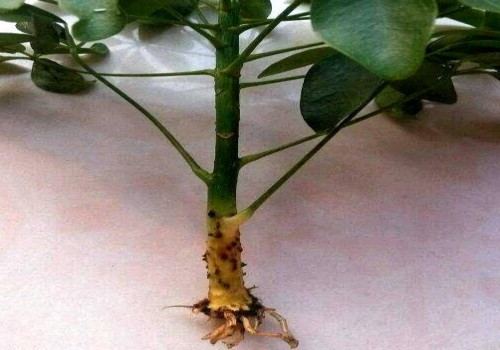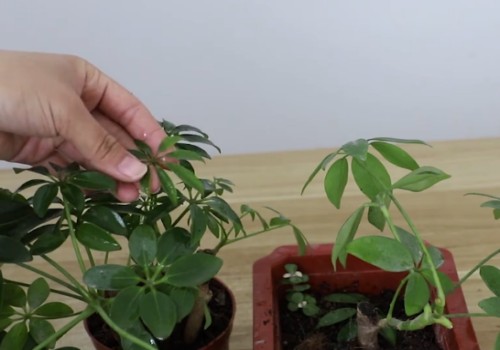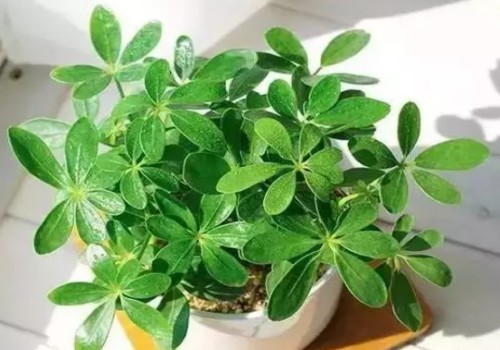How to prevent the roots of duck feet from rotting
Duck foot wood is evergreen all the year round, with peculiar leaf shape, which has high ornamental value and greening and beautification effect. Although the duck foot wood is more resistant to drought and likes the moist growth environment, it is not resistant to waterlogging. If overwatered, stagnant water in the basin will inhibit the respiration of the roots, resulting in rotten roots.

The occurrence of rotten roots in potted plants is something that many potted friends have experienced, and the serious consequence of rotting roots may lead to plant death, which is, of course, something that the majority of potted enthusiasts are extremely reluctant to encounter. So, how to prevent duck feet from rotting roots? Today, the editor will share with you the secret that there are no roots.
In fact, in order to avoid rotting roots of duck foot wood, the most important thing is to take necessary protective measures in addition to the scientific and reasonable maintenance methods, especially watering, because it is inevitable that rotting roots will sometimes be caused by improper watering management. Below, the editor will share three kinds of "materials" for you, which can play the role of never rotting roots after using them.
1. Charcoal
The use of charcoal can prevent duck foot wood from rotting roots, mainly because it has a very strong adsorption capacity, which can not only absorb bacteria, but also absorb water and drain water. Under this dual function, the bacterial infection at the root of duck foot can be prevented, thus the phenomenon of rotting root can be avoided.
And the structure of charcoal itself is also special, the texture is very loose, mixing it into the basin soil can improve the looseness of the soil, so as to improve the drainage capacity of the basin soil. Once we usually overwater, the charcoal in the basin soil can not only absorb the excess water, but also cooperate with the drainage of other substrates.
II. Cinder
It can also be used as a substrate for growing duck feet every day, and coal is rich in mineral elements, which can not only promote the growth of the roots of duck feet, but also make the leaves of the plant grow greener. At the same time, the addition of coal cinder to the basin soil can also improve the loose and permeable effect of the basin soil and make the basin soil more permeable, which can play the role of drainage to a great extent when overwatering.
Third, peanut shell
The peanut shell itself is the fruit shell produced by plants, and the peanut shell is buried in the basin soil. after it becomes mature, it can not only release a large amount of organic matter and nitrogen elements, so as to better promote the growth of duck foot wood, but also improve the soil quality, make the basin soil loose and breathable, and improve the drainage effect of the basin soil.
Does everyone know anything about it? The above are the three kinds of plant materials recommended by Xiaobian, which can be used together with basin soil, which can not only improve the soil quality and improve the permeability of basin soil, so as to avoid stagnant water and rotten roots caused by excessive watering, but also provide rich nutrients for plants.
Time: 2019-05-27 Click:
- Prev

Symptoms of duck feet before rotting roots
Duck foot wood, also known as goose palm wood, is named because its leaves are similar to duck paw or goose paw. It is a kind of evergreen shrub which is very suitable for viewing leaves and potted plants. Although the ornamental value of duck foot wood is very high, but in the actual maintenance process, there are still many people will encounter the loss of leaves, leaves black rot and so on. actually
- Next

How to eradicate the beetle of Duck's foot
Duck foot wood, also known as duck palm wood, although it has luxuriant branches and leaves, evergreen four seasons, has a very high ornamental value, but because many potted friends usually like to put it in the indoor space for maintenance. After a long time, it was suddenly found that the leaves of the plant were covered with scale insects. So, how to eradicate the duck-foot beetle?
Related
- Fuxing push coffee new agricultural production and marketing class: lack of small-scale processing plants
- Jujube rice field leisure farm deep ploughing Yilan for five years to create a space for organic food and play
- Nongyu Farm-A trial of organic papaya for brave women with advanced technology
- Four points for attention in the prevention and control of diseases and insect pests of edible fungi
- How to add nutrient solution to Edible Fungi
- Is there any good way to control edible fungus mites?
- Open Inoculation Technology of Edible Fungi
- Is there any clever way to use fertilizer for edible fungus in winter?
- What agents are used to kill the pathogens of edible fungi in the mushroom shed?
- Rapid drying of Edible Fungi

